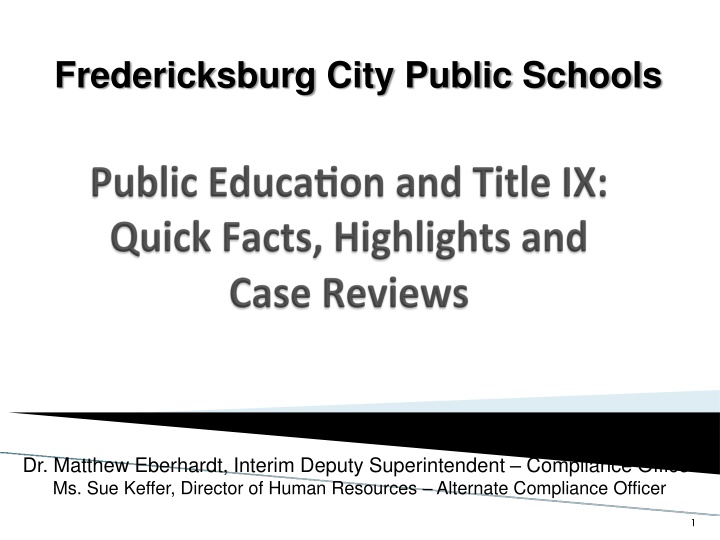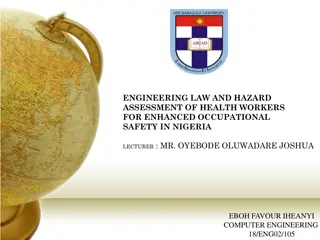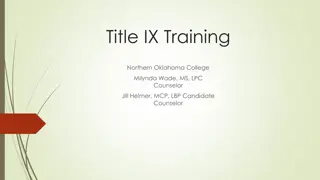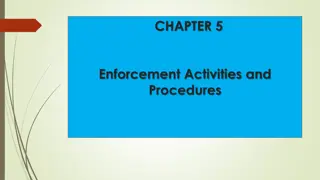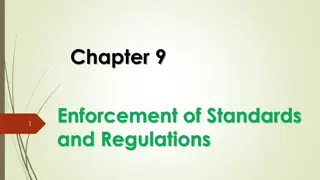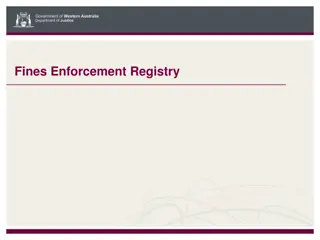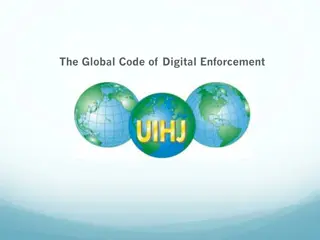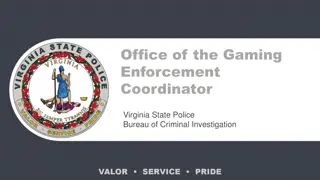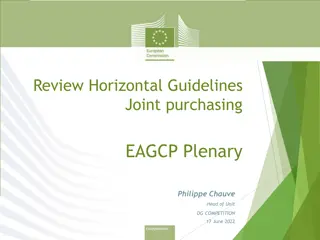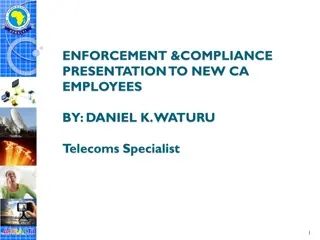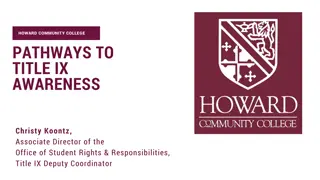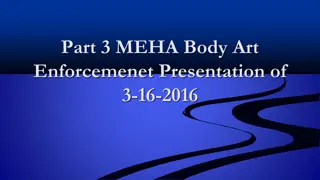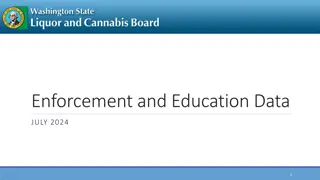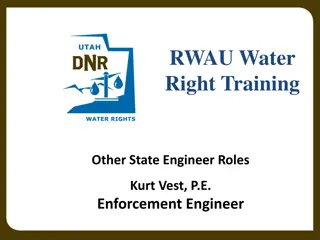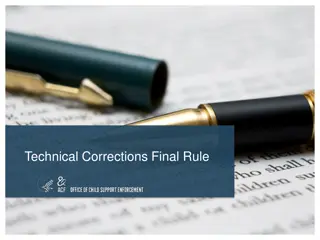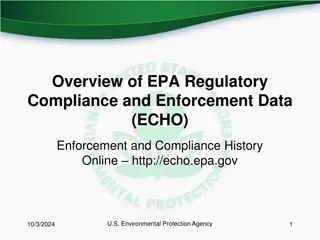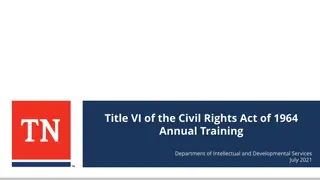Title IX in Education: Compliance and Enforcement
This document provides information on Title IX regulations in education, focusing on compliance, enforcement, and the roles of key personnel such as the Interim Deputy Superintendent and the Director of Human Resources. It covers definitions, obligations, grievance procedures, and examples of violations related to gender-based discrimination. The Office for Civil Rights (OCR) is highlighted as the agency responsible for ensuring schools do not engage in discriminatory practices. Various topics such as sexual violence remedies, training, and establishing investigation procedures are discussed to promote a safe and inclusive learning environment.
Download Presentation

Please find below an Image/Link to download the presentation.
The content on the website is provided AS IS for your information and personal use only. It may not be sold, licensed, or shared on other websites without obtaining consent from the author.If you encounter any issues during the download, it is possible that the publisher has removed the file from their server.
You are allowed to download the files provided on this website for personal or commercial use, subject to the condition that they are used lawfully. All files are the property of their respective owners.
The content on the website is provided AS IS for your information and personal use only. It may not be sold, licensed, or shared on other websites without obtaining consent from the author.
E N D
Presentation Transcript
Fredericksburg City Public Schools Dr. Matthew Eberhardt, Interim Deputy Superintendent Compliance Officer Ms. Sue Keffer, Director of Human Resources Alternate Compliance Officer 1
Table of Contents Perceptions About Title IX ........................................................................... 3 Definition of Title IX ...................................................................................... 4 Definition of OCR ......................................................................................... 5 Dear Colleague Letters ................................................................................ 7 2017 Changes to Federal Guidance ............................................................ 8 Questions & Answers on Campus Sexual Misconduct ................................ 10 Positive Results in Compliance with Title IX ................................................ 18 Examples of Violations ................................................................................ 19 Learning Environment .................................................................................. 20 Schools Obligations .................................................................................... 26 Department of Justice .................................................................................. 30 Bullying and Harassment ............................................................................. 32 Gender-Based Violence ............................................................................... 35 Sexual Violence Remedies .......................................................................... 36 Compliance Public Notice ............................................................................ 38 Recent Changes to Federal Guidance ......................................................... 39 Title IX Coordinator Duties .......................................................................... 41 Notice of Nondiscrimination ......................................................................... 43 Training ........................................................................................................ 44 Establish a Grievance Procedure ................................................................ 45 Establish Investigation Procedures .............................................................. 46 Title IX Coordinator Job Description ............................................................ 47 Basic Title IX Compliance Checklist ............................................................ 48 2
Athletics Girls Students Employee Equal Access 3
20 U.S.C.A. Section 1681 (a) No person in the United States shall, on the basis of sex, be excluded from participation in, be denied benefit of, or be subjected to discrimination under any education program of activity receiving federal funds. 4
OFFICE FOR CIVIL RIGHTS The Office for Civil Rights (OCR) is a sub-agency of the U.S. Department of Education that is primarily focused on enforcing civil rights laws prohibiting schools from engaging in discrimination on the basis of race, color, national origin, sex, disability, age, or membership in patriotic youth organizations. OCR is one of the largest federal civil rights agencies in the United States, with a staff of approximately 560 attorneys, investigators, and other staff. The agency can be found in twelve regional offices and in its Washington, D.C. headquarters. The Office for Civil Rights is responsible for ensuring the compliance by schools that are public entities or recipients of federal education funds with several civil rights laws including: 5
Office For Civil Rights (Continued) Title VI of the Civil Rights of 1964 Title IX of the Education Amendments Act of 1972 Title II of the American with Disabilities Act Section 504 of the Rehabilitation Act of 1973 The Boy Scouts of America Equal Access Act The Age Discrimination Act of 1975 In the case of school bullying school districts may violate these civil rights statutes and the Department of Education s implementing regulations when peer harassment based on race, color, national origin, sex, or disability is sufficiently serious that it creates a hostile environment and such harassment is encouraged, tolerated, not adequately addressed, or ignored by school employees. Under these federal civil rights laws and regulations, students are protected from harassment by school employees, other students and third parties. 6
Dear Colleague Letters During previous administration, OCR increasingly issued what it calls "Dear Colleague Letters" and other guidance documents addressing a variety of civil rights issues on public K-12 school campuses Examples Transgender student issues* Disabled students' access to extracurricular activities Title IX and Pregnant/Parenting Students Discrimination in the administration of student discipline Title IX and Sexual Harassment/Violence* Avoiding discrimination in enrollment practices Bullying of students with disabilities English Language Learner Students and Limited English Proficient Parents 7
2017 Changes to Federal Guidance June 8, 2017 internal memo regarding changes to all investigations Case-by-case Highlighting effort to clear backlog Ending practice of requesting three years of data, except where allegations themselves raise "systemic" issues School divisions can expect less comprehensive data requests from OCR, narrower investigations, narrower remedies, and more emphasis on voluntary resolutions From January -August 2017 - OCR closed almost three thousand more complaints than in all of 2016 75% of closures were dismissals 7 % were administrative closures 2 % were ECR 9 % finding of insufficient evidence 5 % resolution agreements 8
2017 Changes to Federal Guidance Title IX September 22, 2017 - OCR formally revoked Obama administration's Title IX guidance (2011and 2014) that interpreted Title IX to impose new mandates related to the procedures by which educational institutions investigate, adjudicate and resolve allegations of student-on-student misconduct, signaled that it plans to move forward with Title IX rulemaking Also addressed: 2011 letter that required schools to adopt lower preponderance of the evidence standard in administering student discipline instead of higher clear and convincing That Obama-era Department imposed regulatory burdens without affording notice and the opportunity for public comment Possibility that K-12 schools could now rely on law enforcement investigations to satisfy their Title IX investigative obligations (2011 letter expressly prohibited doing so) Going forward, Department will not rely on the withdrawn documents in its enforcement of Title IX New Q & A on Campus Sexual Misconduct and on school compliance with Title IX (*7 pgs. of guidance now vs. 40 pg. 2014 DCL) 9
Q & A on Campus Sexual Misconduct https:/ /www2 .ed .gov/ab out/ offices/I ist/ocr/docs/ga-title-ix-201709.pdf Overall impact of new guidance: Educational institutions may choose to apply the preponderance of the evidence standard or the clear and convincing standard based on student conduct policies Informal resolutions (voluntary) vs. formal investigations Police reports and police process in fact-gathering 2011 Guidance provided that schools could not rely on law enforcement to satisfy their Title IX responsibilities and had to conduct own internal investigations Continues to confirm that schools are responsible for redressing a hostile environment that occurs on campus even if it relates to off-campus activities 10
Q & A on Campus Sexual Misconduct Schools' obligations with regard to complaints: Adopt and publish grievance procedures that provide for prompt and equitable resolution of complaints of sex discrimination, including sexual misconduct: Notice Applies procedures Ensures adequate, reliable, and impartial investigation Prompt time frame Notifies parties of outcome Provides assurance that school will take steps to prevent recurrence and remedy effects 11
Q & A on Campus Sexual Misconduct Interim Measures Individualized services offered to either or both the reporting and responding parties involved in an alleged incident of sexual misconduct Prior to an investigation or while investigation is pending Must make every effort to avoid depriving any student of her or his education Check-in to make sure measures continue to be needed and effective Can include: Counseling Extensions of time or other course-related adjustments Modifications of work or class schedules Restrictions on contact between the parties Changes in work or housing locations Increased security and monitoring 12
Q & A on Campus Sexual Misconduct No specific time frame for "prompt", OCR will evaluate whether school made a good faith effort to conduct a fair and impartial investigation in a timely manner designed to provide all parties with resolution "Equitable" Burden on school to gather sufficient evidence to reach fair and impartial determination Person free of actual or reasonably perceived conflicts of interest and biases for or against any party must lead the investigation on behalf of school Any rights or opportunities that a school makes available to one party should be made available to the other on equal terms - gag orders discouraged 13
Q & A on Campus Sexual Misconduct Equitable" continued Once investigation is opened that may lead to disciplinary action, the school should provide written notice to the responding party of the allegations, including sufficient details and with sufficient time to prepare a response before any initial interview Identities of parties involved Specific section of code of conduct violated Precise conduct allegedly constituting the potential violation Date and location of the alleged incident 14
Q & A on Campus Sexual Misconduct Investigation Report Summarizes relevant exculpatory and inculpatory evidence The reporting and responding parties and appropriate officials must have timely and equal access to any information that will be used during informal and formal disciplinary meetings and hearings The investigator, or separate decision maker, with or without hearing, must make findings of fact and conclusions as to whether facts support a finding of responsibility for violation of school's sexual misconduct policy If complaint presented more than a single allegation of misconduct, a decision should be reached separately as to each allegation Parties should have opportunity to respond to the report in writing in advance of the decision of responsibility and/or at a live hearing 15
Q & A on Campus Sexual Misconduct Disciplinary sanctions Decisions must be made for the purpose of deciding how best to enforce the school's code of conduct Must consider impact of separating student from his or her education Must be proportionate to the violation 16
Q & A on Campus Sexual Misconduct Notice of Outcome (to parents, if under 18; to student, if over 18) Whether it found the alleged conduct occurred Any individual remedies offered to the reporting party Sanctions imposed on responding party that directly relate to reporting party (i.e. an order that the responding party stay away from reporting party) - limitation allows the notice to comply with FERPA Other steps the school has taken to eliminate the hostile environment if the school found one to exist Appeals Can allow appeals solely to responding party or by both parties Informal Resolution If all parties voluntarily agree, the school may facilitate informal resolution including mediation There must be prior full disclosure of allegations and options for formal resolution 17
Positive Results in Compliance With Title IX Access and Inclusion Risk Management and Risk Mitigation Student Learning and Development Demonstrates a commitment to every student 18
Examples of Violations Sexual advances, requests for sexual favors and sexually motivated physical conduct Overt or subtle pressure for sexual activity Sexually offensive verbalization including remarks, teasing , slurs, and innuendo Inappropriate jokes or comments about sex or gender specific traits Conduct that is demeaning or derisive and occurs substantially because of one s gender 19
Learning Environment Recruitment (Charter and Magnet schools) (and special school programs like JROTC, ATC trade-tech, Domestic Engineer-;0) Drop-out rates Fee waiver-or not (State constitutionally free education) Discipline referrals Services for pregnant or parenting teens Referrals and services for Special Needs, ELL programs, tutoring Sexual harassment policies and training 20
Learning Environment Field Trips Extra-Curricular Activities School Buses Prohibition against RETALIATION 21
Learning Environment By putting women in a situation where they re not preoccupied with negative gender stereotypes, you can significantly reduce the gender gap in standardized testing performance. Dr. Mathew McGlone 22
Learning Environment Heightened gender identity can lead to stereotypic conduct Subtle cues in the testing environment can effect results, i.e., having students report their sex for testing demographics (girls aren t good at math) The gender composition of a class Overt statements- Boys will be boys Girls are sugar and spice Big boys don t cry Frequency and maintenance of instructor eye contact by gender 23
Learning Environment Practices you have seen which may reinforce learning environment bias? 24
Learning Environment Seldon v. Livingston, cont. Mid-May, 2006, presentation by Principal Murphy for parents: Sex segregation was to help teachers and parents understand the neurological, developmental, and hormonal differences/ similarities by gender in order to identify strengths and weaknesses of boys and girls. 25
Schools Obligations 1. Once a school knows, or reasonably should have, of possible sexual violence, immediate and appropriate steps must be taken to investigate/determine what occurred 2. If sexual violence has occurred, prompt and effective steps to end the violence must be taken 26
Schools Obligations 3. Must provide a procedure for students to file complaints of sexual violence/discrimination 4. A school s grievance procedures must use the preponderance of the evidence standard to resolve complaints 5. A school must notify both parties of the outcome of the complaint 27
Schools Obligations 6. Must have and distribute a policy against sex discrimination 7. Must have a Title IX coordinator: Title IX of the Education Amendments of 1972 states: Designation of responsible employee. Each recipient shall designate at least one employee to coordinate its efforts to comply with and carry out its responsibilities under this part, including any investigation of any complaint communicated to such recipient alleging its noncompliance with this part or alleging any actions which would be prohibited by this part. The recipient shall notify all its students and employees of the name, office address and telephone number of the employee or employees appointed pursuant to this paragraph. 8. Must take steps to protect the Complainant (and accused harasser), including the provision of interim measures prior to the outcome of the investigation 28
Schools Obligation Schools Cannot: Require that victim/harasser work it out, talk it out, enter into mediation (but can offer informal resolution) Require the victim to change schools, transportation, classes, extracurricular activities Pressure or suggest a victim wait to take action to make a complaint 29
Department of Justice: Policy Guidance: 2010 When bullying/harassment based on sex or gender creates a hostile environment that is serious enough to limit or interfere with a student s ability to benefit from the- Services Activities Opportunities The harassment violates Title IX. 30
Department of Justice: DOJ 2010 Title IX violations Failing to effectively respond to bullying/ harassment of LGBT students Failing to respond to bullying/harassment based on actual or perceived sexual orientation Failing to respond to bullying/harassment based on gender-based expectations for boys or girls (gender stereotypes) 31
Bullying and Harassment Aggression or intentional harm Negative behavior Carried out repeatedly Often involves an imbalance of power Verbal and/or physical and/or visual 32
Bullying and Harassment Cyberbullying: Flaming, stalking, impersonation, posts to or about, etc DOJ definition of cyber-stalking: The use of Internet, e-mail or other electronic communication devices to stalk another person. Sending or posting repeated messages that are intimidating or threaten harm. 33
Bullying and/or Harassment Name calling Denigration Isolation/alienation Violence Threat of Harm Outing Ganging-Up Often includes comments about other class or status 34
Gender-Based Violence Rape Sexual Assault Sexual Battery Sexual Coercion Dating violence 35
Sexual Violence Remedies Schools address alleged sexual violence as a Title IX civil rights issue 1. Provide interim protection and services for victims 2. Systemize cooperation between school officials and local law enforcement 3. Establish comprehensive advisory committees to advise and monitor climate 4. Conduct climate surveys 5. Conduct peer-peer sexual harassment training 6. 36
Sexual Violence Remedies 8. Conduct employee sexual harassment training 9. Publicize school policies where and with whom to file and what to expect from the process 37
Compliance Public Notice Student Handbooks Brochures Catalogs Application Forms Recruitment material Staff and faculty employment applications Website 38
Recent Changes to Federal Guidance February 22, 2017 Withdrawal of statements of policy and guidance reflected in May 2016 DCL on OCR s enforcement of Title IX with respect to transgender students based on gender identity as well as related January 2015 letter Notes that former guidance requiring access to sex-segregated facilities based on gender identity did not contain extensive legal analysis or explain how the position is consistent with the express language of Title IX or undergo any formal public process August of 2016, a Texas court preliminarily enjoined enforcement of the interpretation, and that nationwide injunction has not been overturned March 6, 2017 U.S. Supreme Court vacated and remanded Gloucester County School Board v. G.G. case for further consideration; 4th Circuit remanded to US District court, School Division filed motion to dismiss for mootness May 22, 2018 US DC for EDVA denied School Division motion to dismiss 39
Recent Changes to Federal Guidance June 6, 2017 Internal memo from OCR to regional directors highlighting recent developments in the enforcement of Title IX, specifically with regard to transgender students OCR should rely on the Title IX and implementing regulations as interpreted in decisions of federal courts and OCR documents that have not been rescinded Provided specific examples of when OCR can assert subject matter jurisdiction Failure to resolve a transgender student s complaint of sex discrimination Failure to assess whether sexual harassment or gender-based harassment (refusing to use preferred name or pronouns) of a transgender student created a hostile environment Different treatment based on sex stereotyping Provided appropriate language to use in the case of a complaint dismissal 40
Title IX Coordinator - Duties Develop nondiscrimination policy and notify the school community of the policy and the Title IX Coordinator contact information Oversee all Title IX complaints Identify & address any patterns or systemic problems that arise during review of complaints Be available to meet with students as needed Make sure other job responsibilities don t create a conflict of interest 41
Title IX Coordinator - Duties Provide assistance to Law Enforcement Obtain access to Law Enforcement Investigation notes and findings, as necessary Understand how grievance procedures operate If more than one Coordinator is identified, describe each Coordinator s responsibilities and designate a Coordinator with ultimate oversight 42
Notice of Nondiscrimination General statement Identify Coordinator & how to contact Widely distribute to: Students Parents Employees Applicants for admission & employment Other relevant persons Post: Website Locations throughout school Printed publications Electronic publications Send electronically to members of the school community 43
Training How to report, and to whom How to recognize the nature of sexual harassment and sexual violence Preventive education Victim resources/services Include students, teachers, employees, school law enforcement, administrators, counselors, general counsel, health personnel, advisors, hearing officers/boards, investigators, appeals officers, community members, vendors, etc. Law enforcement should be trained on Title IX grievance procedures and any other procedures used for investigating sexual violence allegations 44
Establish a Grievance Procedure Prompt & equitable resolution Notice of procedures & how to file complaints Apply procedures Designate reasonably prompt time frames for major stages of the process Notice to the parties of the outcome Assurance that preventative measures will be implemented to prevent recurrence or correct discriminatory effects Written language appropriate to the age of the students Easily understood, easily located, widely distributed 45
Establish Investigation Procedures Law enforcement investigation does not relieve the school of its obligation to investigate Prompt, thorough, reliable, impartial Inform & obtain consent from complainant s parents before beginning How to handle a request for confidentiality Take immediate steps to protect the student Don t wait for conclusion of criminal investigation Clear policies regarding when to refer to law enforcement Parties must have an equal opportunity to present relevant witnesses & other evidence Address attorney involvement Provide an appeal process 46
Title IX Coordinator Job Description Develop, Implement, Enforce & Monitor: Policies, Procedures & Practices Training & Educational Materials Processes Regarding Intake, Investigation, Findings & Resolution of Complaints Appropriate Dissemination of Information Institutional Compliance Recordkeeping Establish a process for continual improvement Appropriate dissemination of information (notices of charge, hearing outcome, duty to warn, remedies) Oversee institutional compliance Record keeping may become subject of litigation 47
Basic Title IX Compliance Checklist At least one Title IX coordinator has been designated to coordinate efforts to comply with Title IX, including investigation of any complaints All students and employees have been notified of the name(s), office address(es), and telephone number(s) of the coordinator(s) Grievance procedures for students have been adopted and published Grievance procedures for employees have been adopted and published Climate check Contingency protection plan for the victim during the investigation The following have been notified of a policy of nondiscrimination on the basis of sex: Applicants for admission and employment Students and parents of students Employees Sources of referral of applicants Unions, professional organizations Notification of a policy of nondiscrimination on the basis of sex has been placed in the following: Local newspapers School newspapers and magazines Memoranda or other written communications distributed annually to each student and employee Announcements, bulletins, catalogs, student and faculty handbooks Application forms The above-listed publications are free of text and illustrations suggesting differential treatment on the basis of sex Admission and recruitment representatives (including counselors or student advisors and personnel officers) have been advised of the nondiscriminatory policy and required to adhere to the policy Training is provided for staff and faculty. 48
